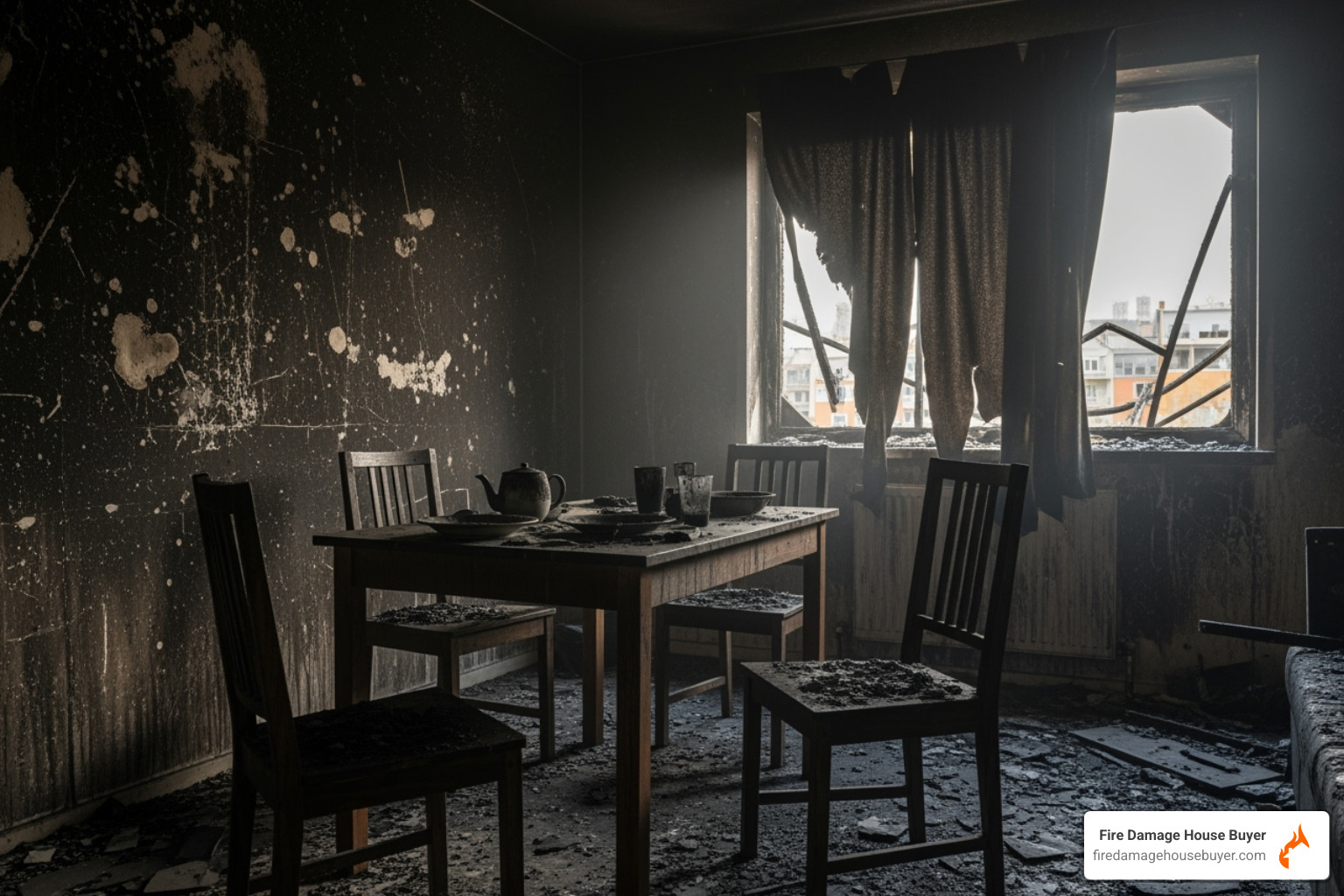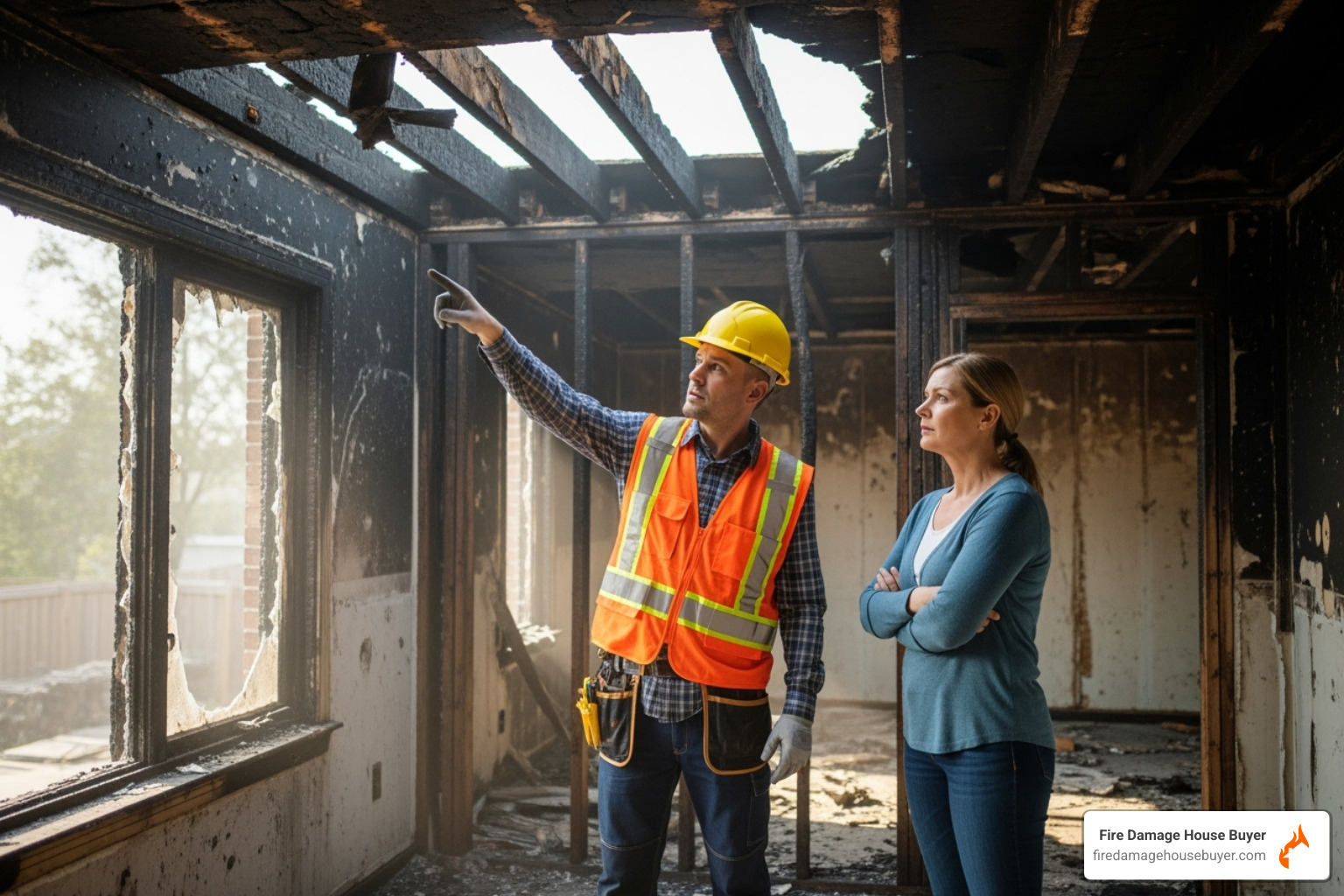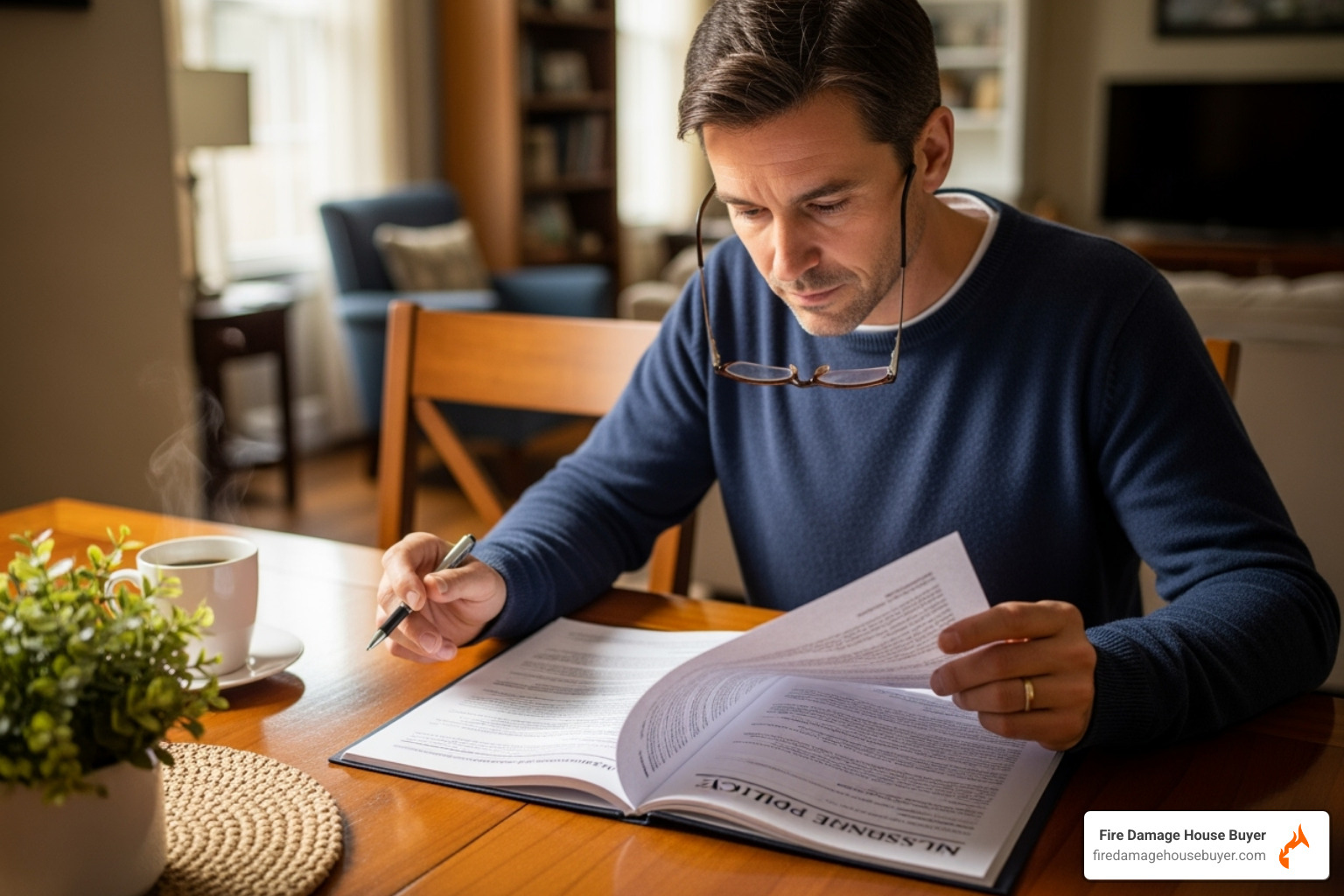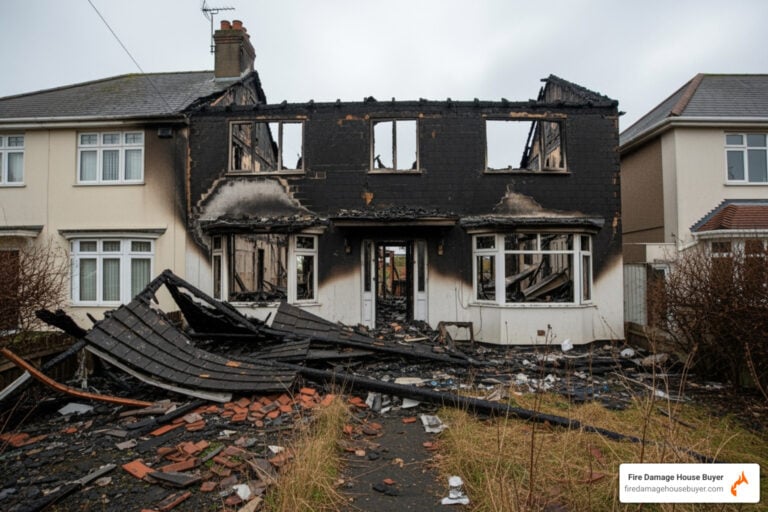Why Understanding Fire Damage Repair Costs Can Save You Thousands
The cost to repair fire damaged house ranges from $3,107 to $51,243 nationwide, with an average of $27,175. However, severe structural damage can push costs up to $180,000 or more.
Quick Fire Damage Repair Cost Breakdown:
- Minor smoke damage: $3,000 – $10,000
- Moderate fire damage: $10,000 – $40,000
- Severe structural damage: $40,000 – $180,000
- Cost per square foot: $4 – $7 (basic to complex restoration)
- Water damage cleanup: $1,000 – $6,000
- Soot and smoke removal: $2,000 – $6,000
- Foundation repairs: $2,200 – $7,800
- Roof replacement: $5,900 – $12,800
The piercing sound of a smoke alarm and the sight of flames create memories that linger long after the fire trucks depart. Beyond the emotional trauma, you face a mountain of financial uncertainty about the cost to repair fire damaged house. Many fire victims wonder if restoration is financially realistic or if there’s a better path forward.
The reality is that most homeowners dramatically underestimate the true repair costs. What seems like “minor smoke damage” can quickly escalate when contractors find water damage, compromised electrical systems, and hidden structural issues.
This guide breaks down every expense, from cleanup to reconstruction, providing real numbers to help you make an informed decision about your home’s future.
As Daniel Cabrera, founder of Fire Damage House Buyer with over 15 years of experience, I’ve helped hundreds of homeowners steer these complex decisions. Through buying and selling over 275 distressed properties, I’ve seen how repair costs can spiral beyond what families can handle.
The Full Cost Breakdown: From Initial Cleanup to Final Reconstruction

Walking into your fire-damaged home is overwhelming. Behind what you can see lies a complex web of restoration work that determines your final cost to repair fire damaged house. Understanding each step helps you prepare for the financial reality ahead.
Water Damage from Firefighting Efforts
Ironically, the water used to fight the fire can cause as much damage as the flames, soaking into floors, walls, and the foundation. Mold can grow in under 24 hours, making immediate action critical.
Water extraction is the first step, where professional crews use industrial pumps to remove standing water. This is followed by drying and dehumidifying, using massive fans and dehumidifiers to pull moisture from all materials, preventing warping and cracking. Finally, mold prevention involves applying antimicrobial treatments to stop growth before it starts.
The cost for water damage cleanup is typically $1,000 to $6,000, or $2 to $4 per square foot. This crucial investment prevents more expensive mold and structural problems later.
Smoke & Soot Contamination Removal
Smoke leaves a toxic residue, and soot invades walls, furniture, clothing, and your HVAC system. The cleanup difficulty depends on the fire type. Dry soot (from wood) is easier to clean than the sticky, acidic oily soot (from plastics or grease), which requires specialized chemicals and costs more to remove.
Professional crews perform methodical surface cleaning on every wall, ceiling, and fixture, using appropriate techniques for each material. Personal property cleaning for items like furniture and clothing is often done off-site, though some items may be a total loss.
Due to health risks from toxic compounds, professional cleaning is essential. Soot removal costs $400 to $1,700, with comprehensive smoke and soot restoration ranging from $2,000 to $6,000. Extensive damage can cost up to $1,200 per room.
For a deeper dive into the restoration process, check out our guide on Fire Damage Restoration Repair.
Deodorizing and Air Duct Cleaning
Even after cleaning, the smoke smell lingers, indicating harmful particles remain in the air. Professionals use several methods to eliminate it.
Thermal fogging uses a special fog to penetrate tiny spaces and neutralize odors at a molecular level. Ozone treatments are also powerful, using ozone generators to break down smoke compounds, but require the home to be vacant during treatment.
HVAC and duct cleaning is crucial, as the system spreads contaminated air. This costs $250 to $500 and prevents odors from recirculating.
Ozone smoke removal costs $400 to $800. Expect to spend $1,000 to $3,500 for complete deodorizing and air duct cleaning.
Rebuilding Specific Parts of the House
After cleanup, reconstruction begins. Costs vary based on the extent of the damage, materials, and desired finishes.
- Kitchen rebuilds: Often the most expensive, ranging from $15,000 to $25,000 per room. Upscale kitchens can cost $50,000 to $70,000 or more.
- Roof damage: Minor repairs cost $400 to $1,800, while a full replacement runs $5,900 to $30,000. Costs per square foot are $7 to $10 for asphalt shingles and $15 to $25 for metal or tile.
- Foundation repairs: Necessary when heat weakens concrete, costing $2,200 to $7,800. Severe damage may require a complete replacement at a much higher cost.
- Drywall and framing: Replacement costs $1,000 to $7,000, depending on the area.
- Electrical system repairs: A critical safety step costing $900 to $3,000. A licensed electrician must inspect and certify all work.
These reconstruction costs are a major part of the total cost to repair fire damaged house, and hidden issues can increase the final bill.
What is the True Cost to Repair Fire Damaged House?

After breaking down the individual repairs, what’s the bottom line? The true cost to repair fire damaged house depends on factors that go far beyond what meets the eye. This section details the overall financial picture and the primary factors that determine your final bill.
National average cost to repair fire damaged house
The numbers can be sobering. Nationwide, homeowners face repair costs that cost between $3,107 and $51,243, with a national average of $27,175. Severe structural damage can push expenses to $180,000 or more.
Fire sprinklers make a huge difference: homes without them average $45,109 in damage, while those with sprinklers average just $2,166. For many families, these high costs determine whether they can rebuild or must start over elsewhere.
Cost Per Square Foot Analysis
Restoration is often quoted per square foot, providing a framework for potential costs based on severity.
- Basic restoration: About $4 per square foot for minor smoke damage, involving deep cleaning and light deodorization.
- Standard restoration: Averages $4.70 per square foot for moderate damage, including significant cleaning, some drywall replacement, and minor repairs.
- Complex restoration: $7 per square foot or more for compromised structures, involving demolition, rebuilding, and system replacements.
Premium materials, labor shortages, or asbestos abatement can increase these costs.
How Property Size, Fire Type, and Location Affect Costs
Three major factors can dramatically swing your final repair bill:
- Home size: Costs scale predictably. A 1,000 sq ft home might cost $4,000-$7,000 to restore, while a 2,500 sq ft home ranges from $10,000-$17,500.
- Regional price variations: Costs vary significantly by location. For example, California averages $91,700 for restoration, while Texas is $58,700. Urban areas are typically more expensive than rural ones.
- Fire type: The source of the fire impacts complexity and cost. Electrical fires ($12,000-$23,000) damage hidden systems. Kitchen oil fires ($12,000-$20,000) leave stubborn, greasy soot. Gas fires ($14,000-$20,000) create intense heat, while ordinary combustible fires ($9,000-$14,000) are often more manageable.
Understanding fire intensity helps predict damage severity. Learn more about the temperatures involved at How Hot Does a House Fire Get?
Hidden costs when you repair a fire damaged house
Surprise expenses can add thousands to your cost to repair fire damaged house. Be prepared for these common hidden costs:
- Temporary housing: While your home is uninhabitable, costs for hotels, rentals, and storage pile up. Insurance may cover these Additional Living Expenses (ALE), but the process can be complex. For immediate help, the Red Cross offers support.
- Building permits and inspection fees: These are mandatory for significant repairs, including building, electrical, and plumbing work. Fees vary by location and are non-negotiable.
- Personal property replacement: The cost of replacing furniture, appliances, clothing, and electronics adds up quickly. Pack-out services to restore salvageable items cost $50 to $100 per pound.
- Air quality testing: This is essential to ensure your home is safe from airborne particles and toxic chemicals before you move back in.
These hidden costs can add $10,000 to $25,000 to your total bill, pushing many homeowners beyond their budget.
Navigating Insurance and Deciding Your Next Steps

After tallying up the staggering cost to repair fire damaged house, you’re probably feeling overwhelmed. Understanding your options is critical when facing daunting repair bills. This isn’t just about money—it’s about your family’s future and whether the financial burden is worth the emotional toll.
How Insurance Coverage Works (and What It Doesn’t)
Your insurance policy won’t automatically cover everything. It’s a contract with specific terms, limits, and exclusions.
Most policies include dwelling coverage (structure), personal property coverage (belongings), and additional living expenses (temporary housing). However, you must understand the difference between Actual Cash Value (ACV), which pays for depreciated value, and Replacement Cost Value (RCV), which pays to replace items with new ones. You’ll also have a deductible ($1,000-$2,500) and coverage limits.
Be aware of exclusions, such as arson or damage to a long-vacant home. The claims process is demanding, requiring extensive documentation. Some homeowners hire a public adjuster (for a fee of 10-15% of the settlement) to help maximize their payout.
For detailed guidance on maximizing your insurance claim, check out our comprehensive Fire Damage Insurance Claims Guide.
Professional Restoration vs. DIY: A Cost-Benefit Analysis
Facing high repair estimates, DIY restoration can seem tempting, but it’s harder and more dangerous than it appears.
Professional restoration costs more upfront but is faster, safer, and more thorough. Pros use industrial-grade equipment and specialized cleaning agents. They know how to find hidden damage and provide the detailed documentation insurance companies require, which helps ensure your claim is approved.
DIY restoration is risky. You could miss hidden water damage leading to mold, fail to remove odors, or create electrical hazards. Insurance companies are skeptical of DIY work and may deny claims if your efforts worsen the damage.
| Aspect | Professional | DIY |
|---|---|---|
| Upfront Cost | Higher, but often recoverable through insurance | Lower materials cost, but hidden costs add up |
| Timeline | 2-8 weeks for most homes | Often extends indefinitely |
| Safety | Trained to handle hazards like asbestos and structural damage | High risk of injury and exposure |
| Insurance | Documentation helps maximize payouts | Claims may be denied for improper work |
| Long-term Results | Warranties and thorough remediation | No guarantees, problems often resurface |
The long-term financial benefits of professional work often outweigh the initial cost savings of DIY. When problems like mold or smoke odors reappear, those “savings” quickly evaporate.
When is Restoration Not Cost-Effective?
Sometimes, the numbers show that your house isn’t worth saving financially. Recognizing this can prevent a worse financial situation.
- Compare repair costs to pre-fire value: If repairs cost $80,000 for a home previously worth $120,000, rebuilding may not be a sound investment, especially considering displacement and stress.
- Consider structural integrity: If the foundation, load-bearing walls, or roof structure are compromised, repairs become extremely complex and expensive. A structural engineer may deem the home unsafe to rebuild.
- Factor in the timeline and stress: A major rebuild can take months or even a year, causing immense stress from managing contractors, permits, and temporary housing. The emotional toll can outweigh any financial benefit.
For these reasons, many homeowners choose a different path: selling their fire-damaged house as-is for cash to move on quickly.
If you’re feeling overwhelmed by the cost to repair fire damaged house and wondering if there’s a simpler solution, read our detailed guide on Rebuild or Sell After House Fire.
Frequently Asked Questions about Fire Damage Repair
When you’re staring at the aftermath of a fire, countless questions race through your mind. Here are answers to the most common concerns.
How long does fire damage restoration typically take?
Fire restoration isn’t a quick fix; the timeline depends on the severity of the damage.
- Minor smoke damage: A few days to a couple of weeks for cleaning and minor repairs.
- Moderate damage: 2 to 8 weeks for significant cleaning and material replacement.
- Major structural repairs: Several months to over a year if rebuilding the foundation, roof, or walls is necessary.
Delays from insurance claims, building permits, and contractor availability can extend these timelines. The longer the project, the higher the cost to repair fire damaged house. Acting within the first 24-48 hours is critical to reduce both the timeline and overall costs.
What items can be salvaged after a fire?
Fortunately, professional restoration techniques can save many items that look hopeless.
Non-porous items like metal, glass, and hard plastics have the best chance of being restored because they don’t absorb smoke and soot. Using specialized techniques, restoration companies can often save precious items like photographs, documents, and electronics.
However, some items cannot be safely restored. Anything with severe smoke, heat, or chemical damage, such as heavily saturated furniture, mattresses, or items touched by flames, usually requires replacement. Porous materials are also challenging, as they absorb toxic compounds, posing a health risk.
A professional restoration company will inventory your belongings to determine what can be salvaged, which is a crucial step for your insurance claim.
What credentials should I look for in a restoration company?
Choosing the right restoration company is crucial for your safety and finances. Look for these credentials:
- IICRC certification: The Institute of Inspection, Cleaning and Restoration Certification is the industry’s gold standard, ensuring technicians are properly trained.
- Proper licensing and insurance: The company must be licensed and carry liability insurance and workers’ compensation to protect you.
- Specific fire damage experience: Fire restoration requires specialized knowledge that general contractors may lack.
- Positive reviews and local references: Check online reviews and ask for references you can contact directly.
- Clear contracts and detailed estimates: Get everything in writing, including services, costs, and timelines. Avoid companies that pressure you or demand large upfront payments.
Choosing the right professional can save you thousands on the cost to repair fire damaged house and ensure your family’s safety.
The Bottom Line: When Repair Costs Are Too High
The reality is clear: the cost to repair fire damaged house is often far higher than expected, with expenses potentially reaching $180,000 or more. Beyond the money, there are months of displacement, stress from dealing with insurance and contractors, and constant worry about hidden problems.
The emotional toll can be harder than the financial one. For many homeowners, the numbers and challenges feel impossible. If you feel overwhelmed, know that restoration isn’t the right path for everyone.
There’s a simpler solution. Instead of enduring a long and stressful restoration, you can sell your house as-is and move forward immediately.
Fire Damage House Buyer purchases fire-damaged properties in any condition, nationwide. We handle everything, so there are no repairs, commissions, or hidden fees. We can close in as little as 7-14 days.
This means you could have cash in hand and be looking for a fresh start within two weeks, bypassing the uncertainty and stress of rebuilding. If the restoration costs and timeline feel like too much, selling for cash offers peace of mind.


